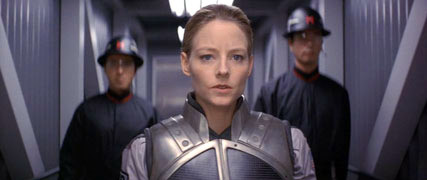I know that the movie has been out for quite some time–the original release date being 11 July 1997–but I recently watched it again and believe that a critique is in store. This film was an attempt to capture all the complexities and mind-bending ideas of Carl Sagan’s book of the same name. Sagan didn’t just write a science fiction book about alien life, worm holes, and government attempts to cover up unexplainable happenings. Instead, his book, and consequently this film, grappled all the political bouts, scientific argumentation, religious qualms, and personal struggles for understanding that surround a breakthrough of any kind. In this particular film, that breakthrough happened to be making contact extraterrestrial life.
This movie brought all of those interwoven perspectives to the forefront and presented them in a way that made one feel both enlightened and boggled. At one point it may seem like one should favour science and fully support Dr. Arroway (Jodie Foster) in her battle for recognition of her discovery. Moments later, a persuasive argument from Palmer Joss (Matthew McConaughey) will make one rethink one’s beliefs about the impact of science on human life and social development. With all of these ideas flying around, the viewer has the option of simply shrugging them off as political mumbo-jumbo, or actually genuflecting and assimilating the new perspectives in with one’s current schemata.

Regarding other aspects of quality filmmaking, this particular movie didn’t have anything wildly impressive in the way of cinematography other than its use of vivid colours in the penultimate scene. Most of the camera angles were quite typical of dramatic productions, and the lighting was nothing out of the ordinary. Character development was steady, yet overtly linear. Despite these areas that could have been more artistically done, the content of the movie earned it a high rating in my eyes. However, I cannot give this movie a perfect score, nor as high of a score as I would potentially like. “Well why not?,” you might ask. As trivial as it may seem on the surface, one particular scene caused me to question a lot of the otherwise nicely executed character roles. In the scene in which Dr. Arroway and Palmer Joss are standing out on the balcony at the ceremonial ball, Arroway brings up the scientific statute of Ockham’s Razor (sometimes referred to as “Occam’s Razor” or even as the “law of parsimony,”). Joss acts puzzled by the mere mentioning of the principle and aptly states “it sounds like some sort of slasher movie.” While I don’t necessarily expect anyone and everyone to know that it is the principle stating that entities should not be multiplied beyond necessity, I would expect a theologian specialising in and writing a book on the interplay between science and religion to not only know of the Razor but to have also extensively pondered its multifaceted implications for both disciplines, respectively (McGrade, 2002). That error, in my opinion, is large enough to make a viewer question the rest of the research that went into character formation.
That being said, I did like this film very much, and give it 7 stars out of 10. 🙂










|:| Zach |:|
———-
REFERENCES:
McGrade, A.S. (2002). The political thought of William Ockham. Cambridge: Cambridge University Press.


2 comments
Let’s not forget those gorgeous dimples and that great laugh of Matthew’s.
Did I ever tell you about the class I got a D in that was solely based on the Carl Sagan “Cosmos” text book…
Apparently – the tree is our cousin. 🙂
Ask me about it sometime!
(Oh yeah and my professor actually met Carl or Carl’s ex-wife… I can’t remember which)